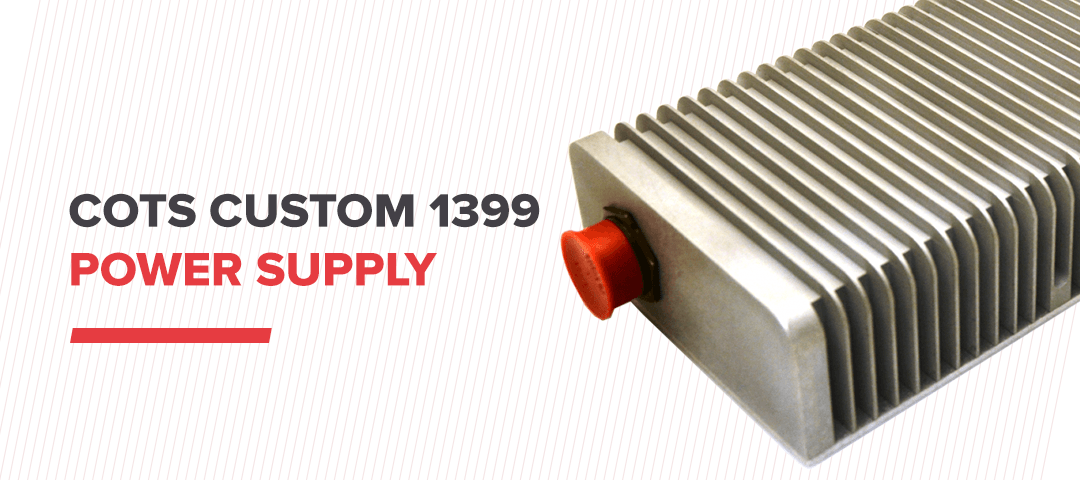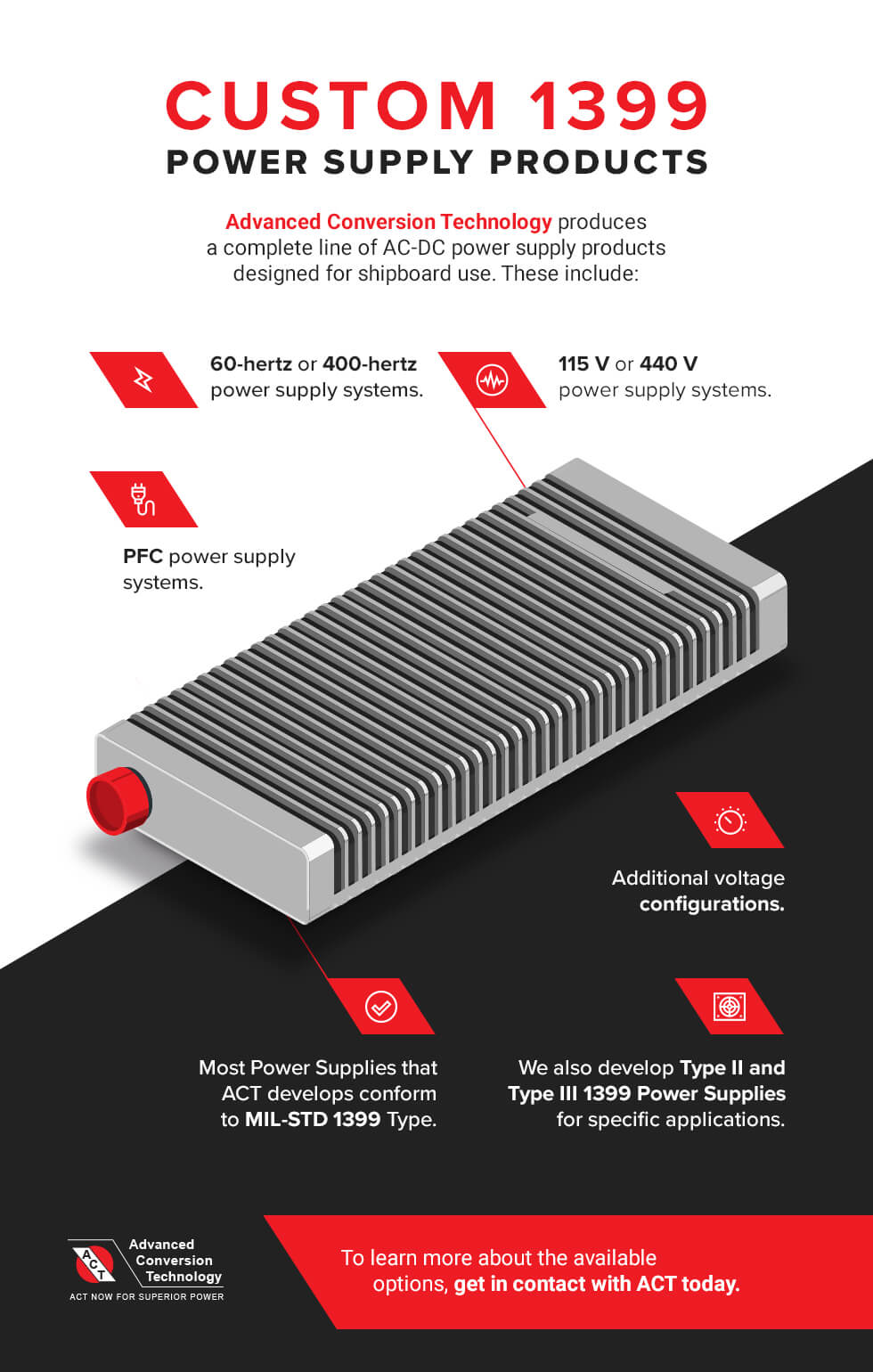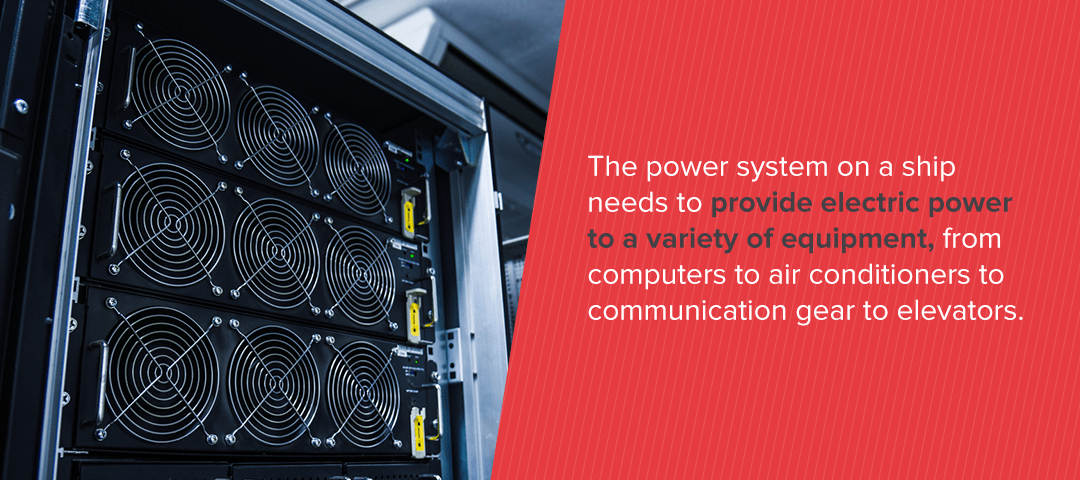
Quick Navigation:
- Types of Shipboard Power
- What are the MIL-STD-1399 Requirements?
- Requirements for Shipboard Power Supplies
In many ways, a ship is a city unto itself. When it’s at sea, it needs its own power system to keep everything up and running, from the machinery in the engine room to the ovens and equipment in the kitchen. Military standard 1399 Section 300 (MIL-STD-1399-300) was first created in 1978 to create standards for electric power system characteristics, which shipboard power supplies need to adhere to. It has been updated and revised periodically since then. The most recent revision, from 2018, divided Section 300 into two parts: low-voltage (Part 1) and medium-voltage (Part 2).
MIL-STD-1399-300 is an essential set of standards for use on military vessels, as it outlines best practices for project managers and engineers to follow. Onboard ships, there is a need to minimize total harmonic distortion, reducing the risk of interference with onboard system components. COTS-like custom 1399 power supplies provide the interface between the source of AC power found on a ship and the utilizing equipment while maintaining acceptable levels of total harmonic distortion.
Understanding the types of power allowed under MIL-STD-1399 and the requirements of the standard will help you determine the type of power supply your piece of equipment needs to operate on a ship.

Types of Shipboard Power
MIL-STD-1399-300-1 outlines three types of low-voltage (less than 1kV) electric power classifications that can be supplied onboard ships. In addition to three basic types of power, the standard also defines special classifications, which are permitted in specific instances. The primary low-voltage types are:
- Type I: Type I power is by far the most commonly used shipboard power source, as the other types require a deviation. Type 1 power is 115 volts root mean square (Vrms), 60 Hz or 440 Vrms, 60 Hz. Interfaces with 440 Vrms can be single or three-phase. Although ungrounded is most common, there is the option for Type I 440 Vrms to be high-resistance grounded. Interfaces with 115 Vrms are also either single or three-phase and can be solidly grounded or ungrounded.
- Type II: Type II power has very limited application. It is either 440 Vrms, 400 hertz or 115Vrms, 400 Hz. If you wish to use a Type II power, you need to submit a deviation request and have it approved.
- Type III: Like Type II, Type III power sources are either 440 or 115 Vrms, 400 Hz. They are ungrounded. The tolerances for Type III are tighter than for Type II. Its use is also restricted and requires you to submit a deviation request for approval.
In addition to the three types of power classifications above, MIL-STD-1399-300-1 describes a few special types of classifications, designed for specific circumstances. For example, a 1399 power supply used to run equipment that is for servicing aircraft on flight decks, hangers, hotel services and avionic shops needs to run off Type I, 115/200 Vrms, 60 Hz, three-phase, grounded neutral, four-wire wye. For Landing Craft Air Cushion systems (LCAC), avionic shops, and servicing aircraft on flight decks or in hangars, Type III power can be used, 115/200 Vrms, 400 Hz, three-phase, grounded neutral, four-wire wye.
The power supply used to power NATO load equipment needs to run off Type I which is 230 Vrms, 60 Hz, three-phase ungrounded or single-phase ungrounded or grounded. The spike voltage will be 1400 V peak.
There are also special power options for shipboard industrial equipment, such as washers and dryers. If a non-standard power is used, it needs to comply with the same tolerances as a Type I.
Therefore, when looking for a MIL-STD-1399 power supply, the classification type is needed as well as the details of the voltage, number of phases, and frequency in order to specify what input voltage the power supply will be operating off to convert to the output voltages needed to run your system.
What Are the MIL-STD-1399 Requirements?

The power system on a ship needs to provide electric power to a variety of equipment, from computers to air conditioners to communication gear to elevators. Ideally, the ship will be designed in such a way that the need for conversion equipment is reduced and that most of the equipment that needs electricity can operate off a Type I, 60-Hz power source. Reducing or eliminating the need for power supplies that run off Type II or Type III will help to improve the overall performance of a ship.
Understanding the general requirements found in paragraph 4 of MIL-STD-1399-300 Part 1 will help you specify the appropriate power supply for your application going on a ship. Here’s a quick rundown of some of the standard’s requirements:
- Interface requirements: The interface requirements created by MIL-STD-1399 are mandatory and need to be followed by any shipboard power supply and by the equipment designed for use on a ship.
- Conformance test requirements: MIL-STD-1399 includes a table that lists the tests that need to be performed to make sure that equipment conforms to the interface requirements. Examples of requirements and compliance tests include grounding, type of power, number of phases, operating frequency, operating voltage, power factor, current load unbalance, pulsed loading, ramp loading, and voltage and frequency tolerance.
- User equipment: Equipment needs to be powered by a system that has specific characteristics. Any equipment on the ship needs to be designed with the specific power constraints in mind.
- Deviations, tailoring and waivers: Power interfaces discussed in MIL-STD-1399 are based on what is known about typical AC power systems on ships. A deviation or waiver can be considered in particular instances and for specific applications. The waiver or deviation request needs to be submitted during the early development stage of equipment. Tailoring might be required in certain cases, such as when large loads are present.
Requirements for Shipboard Power Supplies
Total harmonic distortion (THD) should, in most circumstances, be as low as possible and target less than 5% for maximum THD. Low THD is particularly important onboard a ship, to keep electromagnetic transmissions low and to reduce the risk of overheating. There are currently two methods that are accepted for use in managing THD and interference in power supplies on ships:
- Active power factor correction (PFC).
- Polyphase transformers in combination with tuned LC filters
Advanced Conversion Technology offers both options, but recommends PFC for shipboard power supplies.
Advanced Conversion Technology Offers Custom 1399 Power Supply Products
Advanced Conversion Technology (ACT) produces a complete line of AC-DC power supply products designed for use onboard ships. Among the custom MIL-STD-1399 power supply products we offer are:
- 60 Hz or 400 Hz power supply systems.
- 115 V or 440 V power supply systems.
- PFC power supply systems.
- Additional voltage configurations.
ACT’s power supply products are available in rugged housings that provide protection against shipboard hazards, such as salt and moisture. We’re here to help you develop the appropriate power supply based on the demands of your application.
Learn more about our shipboard power supply options and browse our COTS-like military-grade power supplies. If you have any questions about your specific application, contact us today, and we’ll be happy to discuss options with you.
